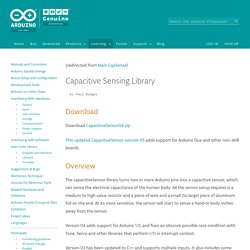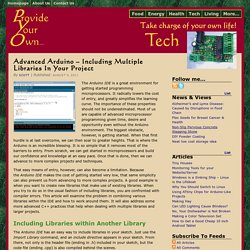

Playground - CapSense. (redirected from Main.CapSense) by Paul Badger Download Download CapacitiveSensor04.zip This updated CapacitiveSensor version 05 adds support for Arduino Due and other non-AVR boards.

Overview The capacitiveSensor library turns two or more Arduino pins into a capacitive sensor, which can sense the electrical capacitance of the human body. Version 04 adds support for Arduino 1.0, and fixes an obscure possible race condition with Tone, Servo and other libraries that perform I/O in interrupt context. Version 03 has been updated to C++ and supports multiple inputs.
Applications Capacitive sensing may be used in any place where low to no force human touch sensing is desirable. A capacitive sensor covered with paper or other insulator also acts as fairly good (human touch) pressure sensor with an approximately logarithmic response. How it works The capacitiveSensor method toggles a microcontroller send pin to a new state and then waits for the receive pin to change to the same state as the send pin. ArduBlock. Advanced Arduino – Including Multiple Libraries In Your Project. The Arduino IDE is a great environment for getting started programming microprocessors.

It radically lowers the cost of entry, and greatly simplifies the learning curve. The importance of these properties should not be underestimated. Most of us are capable of advanced microprocessor programming given time, desire and opportunity even without the Arduino environment. The biggest obstacle, however, is getting started. When that first hurdle is at last overcome, we can then soar to greater heights. That easy means of entry, however, can also become a limitation.
Including Libraries within Another Library The Arduino IDE has an easy way to include libraries in your sketch. Now, say we are developing a more complex project that will use a library of our own. In this example, in my header file, I’ll provide a forward declaration to the class Bounce, and then in my code file, I’ll include the Bounce library.
Getting Your Library to Compile while including a Library #include ".. Conclusion. Install the Arduino IDE in Ubuntu 12.04. Installing the Arduino IDE in Ubuntu only takes a few minutes.

As usual, it’s a better idea to install the Arduino straight from the source, instead of relying on the version in Ubuntu’s repository. While it wasn’t hard to install the Arduino IDE, I noticed that the Arduino GUI was really slow and laggy. This is because the startup script tells Java to use Ubuntu’s GTK look and feel, which makes everything run slowly. It’s easily fixed by changing a single line in the startup script. Update: In the Arduino 1.0.1 update, “Serial Port” is greyed out. Install the Arduino IDE in Ubuntu Install gcc-avr, avr-libc and openjdk-6-jre if you don’t have it already.Plug in the board, see where it’s connectedDownload and unpack the Arduino IDEtarballRun the IDESelect your board model and serial portRun a sample programFix the buggy interface (optional)Troubleshooting Everything worked out of the box, other than the interface. Install gcc-avr and avr-libc Install gcc-avr and avr-libc for the Arduino IDE.